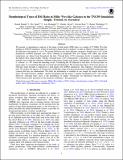Morphological Types of DM Halos in Milky Way-like Galaxies in the TNG50 Simulation: Simple, Twisted, or Stretched
Author(s)
Emami, Razieh; Genel, Shy; Hernquist, Lars; Alcock, Charles; Bose, Sownak; Weinberger, Rainer; Vogelsberger, Mark; Marinacci, Federico; Loeb, Abraham; Torrey, Paul; Forbes, John C; ... Show more Show less
DownloadPublished version (6.636Mb)
Publisher Policy
Publisher Policy
Article is made available in accordance with the publisher's policy and may be subject to US copyright law. Please refer to the publisher's site for terms of use.
Terms of use
Metadata
Show full item recordAbstract
<jats:title>Abstract</jats:title>
<jats:p>We present a comprehensive analysis of the shape of dark matter (DM) halos in a sample of 25 Milky Way-like galaxies in TNG50 simulation. Using an enclosed volume iterative method, we infer an oblate-to-triaxial shape for the DM halo with median <jats:italic>T</jats:italic> ≃ 0.24. We group DM halos into three different categories. Simple halos (32% of the population) establish principal axes whose ordering in magnitude does not change with radius and whose orientations are almost fixed throughout the halo. Twisted halos (32%) experience levels of gradual rotations throughout their radial profiles. Finally, stretched halos (36%) demonstrate a stretching in the lengths of their principal axes where the ordering of different eigenvalues changes with radius. Subsequently, the halo experiences a “rotation” of ∼90° where the stretching occurs. Visualizing the 3D ellipsoid of each halo, for the first time, we report signs of a reorienting ellipsoid in twisted and stretched halos. We examine the impact of baryonic physics on DM halo shape through a comparison to dark matter only (DMO) simulations. This suggests a triaxial (prolate) halo. We analyze the impacts of substructure on DM halo shape in both hydrodynamical and DMO simulations and confirm that they are subdominant. We study the distribution of satellites in our sample. In simple and twisted halos, the angle between satellites’ angular momentum and the galaxy’s angular momentum grows with radius. However, stretched halos show a flat distribution of angles. Overlaying our theoretical outcome on the observational results presented in the literature establishes a fair agreement.</jats:p>
Date issued
2021Department
Massachusetts Institute of Technology. Department of Physics; MIT Kavli Institute for Astrophysics and Space ResearchJournal
Astrophysical Journal
Publisher
American Astronomical Society
Citation
Emami, Razieh, Genel, Shy, Hernquist, Lars, Alcock, Charles, Bose, Sownak et al. 2021. "Morphological Types of DM Halos in Milky Way-like Galaxies in the TNG50 Simulation: Simple, Twisted, or Stretched." Astrophysical Journal, 913 (1).
Version: Final published version